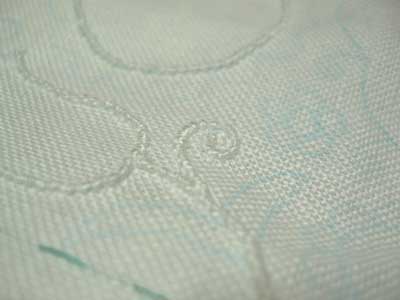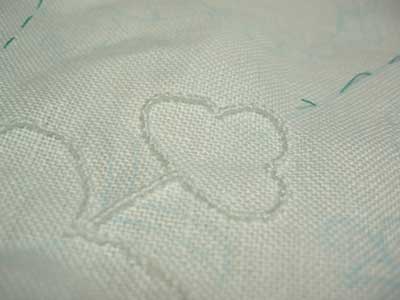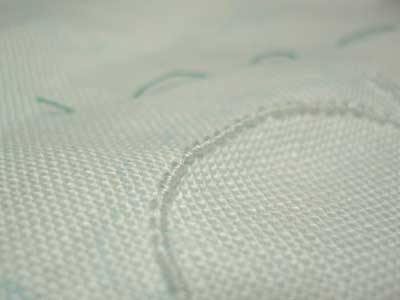Last week, I showed you my set-up for the Schwalm embroidery project I’m working on, from Luzine’s book, Basic Principles of Schwalm Whitework Embroidery. Well, after a slight kerfuffle, all is underway again, and I’ve even begun stitching.
I’ve just managed to stitch in some of the coral stitch outlines around the motifs on only one of the four sides of the tea cloth design. I’ve discovered a couple points I’ll share with you here. Even if you aren’t interested particularly in Schwalm whitework, they may serve you in some other embroidery-related endeavor!

Frist of all, when working coral stitch, it’s helpful to work up a bit of a “rhythm” to the stitch. When I first started stitching the coral stitch outlines, I didn’t realize how important it is to really concentrate on getting the rhythm of the stitch. I’d stitch a wee bit, then get interrupted, add a few more stitches a bit later, get interrupted, etc. These stitches are uneven and inconsistently spaced. Over all, I don’t think this will show up in the finished piece, so I’m not that worried about it. But once I had a stretch of time to stitch, I found that the stitch became quite quick to work and the spacing and tension of the knots evened out considerably.

I’m an avid hoop or embroidery frame user. You probably have realized that if you’ve been reading me for very long! But – not all stitching is for the hoop! In my mind, some stitching simply requires a hoop or frame. For example, I would not, personally, attempt a nice satin stitch, any kind of drawn thread work, or needlepainting without one. But then, there are some stitches that work out better in hand. “In hand” implies embroidery that is stitched with the fabric held in the hand, without the aid of a hoop or frame or any other device to supply tension. And coral stitch – especially in the quantity on this Schwalm piece – works best in hand.
Not only does the stitch work up a whole lot faster, but the tension is overall better on each knot, when worked in hand rather than in a hoop. That’s what I found, anyway!

Another thing I have discovered while stitching this piece in hand: the watercolor pencils I tested for transferring an embroidery design tend to rub off and fade, due to the touching and holding of the fabric. The other three sides of the Schwalm design have more or less faded off, and I will have to retrace them. On the side I’m working on, I’m having to retrace each element of the design as I get to it. C’est la vie!
I’ve got a couple ideas to test about design transfer – including Papermate Flair Ultra Fine markers – specifically in green. A kind reader wrote and told me that’s what she uses, and the green works well (the other colors not as well). I’m eager to try this – I wonder how it will work with white threads on white fabric. (Thanks for that tip, Jean!)
In the meantime, I suppose I’ll stick with re-tracing as I go. Though I might just break out the regular water-soluble fabric marker…. we’ll see. Those tend to fade, too, a bit. But maybe they would hold up better than the pencils are right now!
Anyway, whichever direction I go with the design transfer, I’ll be sure to keep you posted.
In the meantime, I’ll keep plugging away with the Schwalm project. I like working on it so far! And I’m looking forward to adding different stitches – I think buttonhole scallops are next.
Oh, and a final thing I’ve learned: I take rotten photos of white-on-white embroidery. I need to research a bit to find out how to remedy that! Any tips you all may have would be wildly welcomed!
That’s my project update. What are you up to? Whatever it is, I hope you’re enjoying wielding your needle, too!







Hi Mary, looking good so far.
Somethings are just very difficult to photograph well. White on white, anything the shines and the black beads on black that I am currently working with.
I find a soft even light is best, outside on an overcast day is my favourite choice.
I think that you can get a photography 'tent' that gives an all round soft light.
CA
Hi Mary, In my opinion white color shows much details in low brightness. May be you can try making the picture black-and-white.
Or, using any photo editing tool, reduce the brightness, and increase the contrast a little bit.
Have you tried to lightly go over the watercolor pencil with a very light brush using water? That may set the color long enough to finish your piece until you can soak it to get the color off.
Just a thought.
Ren
Hi Mary,
Overall, the photography on your site is amazing, but I see your problem with the white-on-white. Some time ago you played around with natural light slanting through a window and it really popped the stitching. Having worked in photography for many years I can tell you that was the correct solution. Keep your light source low and to the side and let the shadows tell the story.
It's great. And photos are good. I should wish mine were so good…
Now I'm so relaxed, Mary!
I'm doing the coral knots without hoop. I also think that rythm is needed.
Tomorrow I hope to write something about my progress.
Hello Mary,
A suggestion for the photography – try putting something dark under your fabric. If it shadows through it may create more of a contrast between the fabric and thread.
It is looking good so far.
SJ
Late last night I've posted about my progress…